2023.08.02.77
Files > Volume 8 > Vol 8 No 2 2023
Effect of various tractor speeds on potato digger performance

Galib A. A. Alkaabi1,*, and D. Firas S. Al-Ani2
1 Shatrah. Technical College. Iraq
2 Sothern Technical University, Iraq
* Correspondence: [email protected]
Available from: http://dx.doi.org/10.21931/RB/2023.08.02.77
ABSTRACT
A field experiment was conducted in one of the fields of the Technical Institute in Shatrah in 2022 to study the effect of different tractor speeds, conveyor chain speeds and their type on some performance indicators of a potato digger. Severely scratched tubers and slightly marked tubers and quantitative loss were studied in this research. The hand involved three levels of tractor forward speeds (2.5, 3.20,4.0 km / h), two groups of conveyor chain speeds (43, 49) m/ min and two levels of the type of chain conveyor of iron bars and rubber-coated. The complete random design with three replications was used in the research. The results showed that the tractor speed of 2.5 km/h gets the severely scratched tubers, which amounted to 3.03%, and the slightly scratched amounted to 12.37%, and the lowest quantitative loss was 1.16%. The speed of the chain conveyor, 43 m/min, get the lowest percentage of severely scratched tubers, which amounted to 4.53% and was slightly irritated. It was 14.10%, and the speed of the chain conveyor was 49 m/min. The lowest quantitative loss was 2.09%, and the rubber rods had the lowest percentage of severely scratched tubers, slight marked and quantitative loss.
Keyword: qualitative loss, severely scratched, slightly scratched.
INTRODUCTION
Technological processes for harvesting a particular crop require the optimum use of the equipment in certain growing conditions for each crop to ensure the rapid collection of the resulting crop, transportation, cleaning and other additional treatments and reducing losses at a relatively low cost 1 . The introduction of mechanization in the operations of planting the crop and its extraction will help to reduce workforce, reduce production costs and shorten the time and effort to perform all functions, and then increase production and speed all operations, which is required when implementing any agricultural process 2. In a study on the development of a mechanical separation system for potato tubers in a locally designed and manufactured potato digger, the reason for the slightly higher percentage of scratched tubers is the effect of the roughness of the tubers separating system, which is intended for the vibrating chain conveyor as well as the force of strikes on tubers by the vibrators during their transmission 3. On the Conveyor, the main reason and the critical factor in the slight scratching in the tubers are due to the tilt of the vibrating chain conveyor at an angle from the ground surface 4. Several essential factors determine the number of bruises that occur in potato tubers, whether these bruises affect the peel or are simple, including the condition of the soil, whether it is wet or dry, the type of soil, as well as the condition of the tubers, whether they are fully ripe or otherwise, and the temperature The soil, the type of harvesting process, mechanical or manual, the type of machine used, the accuracy of its calibration, as well as the time of 5. Many researchers and scholars believe the type of harvester and its technical specifications have a significant relationship and impact on the percentage of damage to the tubers and the quantitative loss that occurs during the crop extraction (Al-ani2006 ، ). Some have developed potato extraction machines and provide ideal harvest conditions to enhance the results for research purposes, such as the study carried out by 6 .7 used rubber-coated chain conveyors as one of the essential ways to reduce the damage that occurs in tubers and as one of the preventive methods to reduce the loss and significant and slight damage to tubers. 8 Believed that the ratio between the machine's forward speed and the chain conveyor's speed is more important than the forward speed only and that tuber damage can increase with the increase in the machine's forward speed. 9 The front speed of the tractor and the speed of the engine are essential factors and have a positive effect on the performance of the tractor and the machine When the engine speed is increased from 1250 rpm to 1500 rpm, and the tractor's top speed is used 0.95 m/min the amount of fuel consumption decreased from 26.61 kg/ ha to 9 .63 kg/ha, which is A significant decrease and a clear improvement in the performance of the tractor and the implement 10. Because of the importance of studying the potato digger with the chain conveyor and the lack of studies and researchers in this regard, this study came intending to design and develop a machine for extracting, collecting and isolating the coarse potatoes from the soft ones in the least possible time, without any workforce, and with integrated mechanization identification and reduction of damage to the tubers in each part at the digger.
MATERIALS AND METHODS
This fortress comprises a triangular rail on the M, with a width of 64 cm, and two pieces inclined inward at an angle of 25 degrees. They are located in the front, and because the weapon rail is situated on the front of the digger , this helps to push the tuber with to the top, where it falls on a closed chain conveyor with iron plates 94 and 46-cm-wide slab which extends across the width of the pod with 2.5-cm spacing between the bars allowing the plucked potato tubers to move to the rear while lumps, impurities and plant debris fall through the spaces between the rear-swivel chain-carrier panels where they are mounted on a number of star wheels and two pairs of oval wheels, each two wheels on one side of the structure to give vibrating movement and to get rid of the dirt blocks stuck to the tubers, and the presence of cylindrical wheels at the back of the digger works to support the machine's structure as well as its essential role in giving an inclination to the take-off angle (25) degrees that takes its movement from the rear drive shaft of the puller PTO through a group of gears pivoting a bevel kit and a crown gear that connects at the end of the drive shaft the power take-off shaft of the puller and in Its end from the top touches the equipment to the movement and is connected at the top of the digger from the front by means of the three points. When the potato tubers reach the back of the chain conveyor, they fall directly due to the ground force on a side conveyor that takes its movement from the back of the rear drive shaft with the pulley through pulleys and the belt to be conveyed. The large-sized potato tubers are transferred to the side packing and bagging unit, and when the weight inside the bag reaches a weight of 30 kg, the bag will fall by itself. A closed conveyor belt has been manufactured that rotates backward with the same rotation as the chain conveyor of the digger to transport the small and soft potato tubers with a radius of less than 7 cm. A second bagging unit is connected at the back of the digger. Then, the process of extracting the tubers has been completed mechanically and entirely without labor needing to collect the potatoes from the ground.

Figure 1. Components of potato digger with side and rear Conveyor.
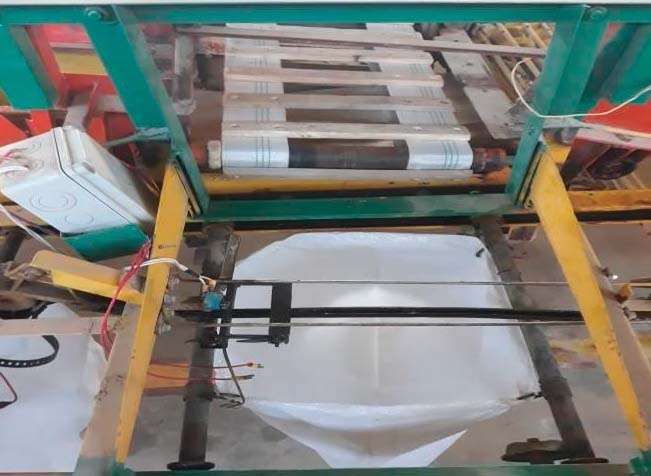
Figure 2. Gears and chain transmission
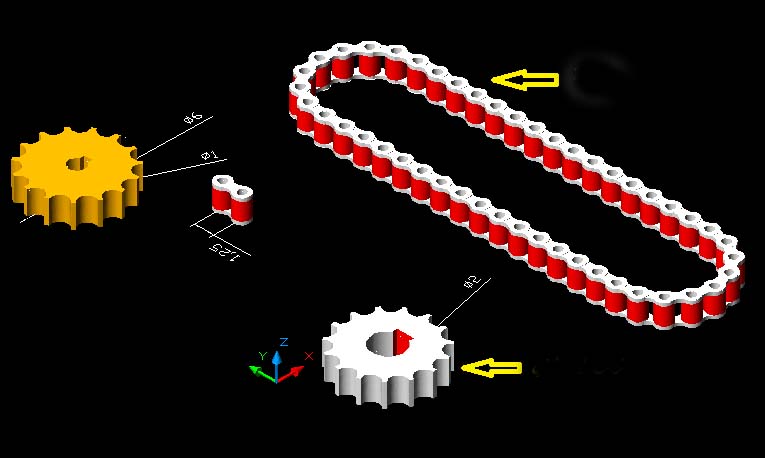
Figure 3. Side and the rear Conveyor
RESULTS
% Severely scratched tubers
Table 1 shows the effect of the tractor's speed, the speed of the chain conveyor, the type of chain conveyor, and the interactions between them in the slightly scratched tubers, increasing the tractor speeds from 2.5 to 3.20 and then to 4.00 km .hr-1caused an increase in severely scratched tubers from 3.03 to 5.00 and then to 7.02 %. Table 1 shows the effect of the speed of the chain conveyor on severely scratched tubers, as it is noted that the speed exceeded 43 m/min in achieving the lowest percentage of scratched tubers, which amounted to 4.53 %, while the highest percentage of the rate of severely scratched tubers was in the speed of the chain conveyor 49 m/ min amounted 5.50 %. The table shows the effect of the type of chain conveyor on the percentage of severely scratched tubers, where the rubber-coated type of rods outperformed in achieving the lowest value, amounting to 4.92 %, while the highest rate was in iron rods, amounting to 5.12%.
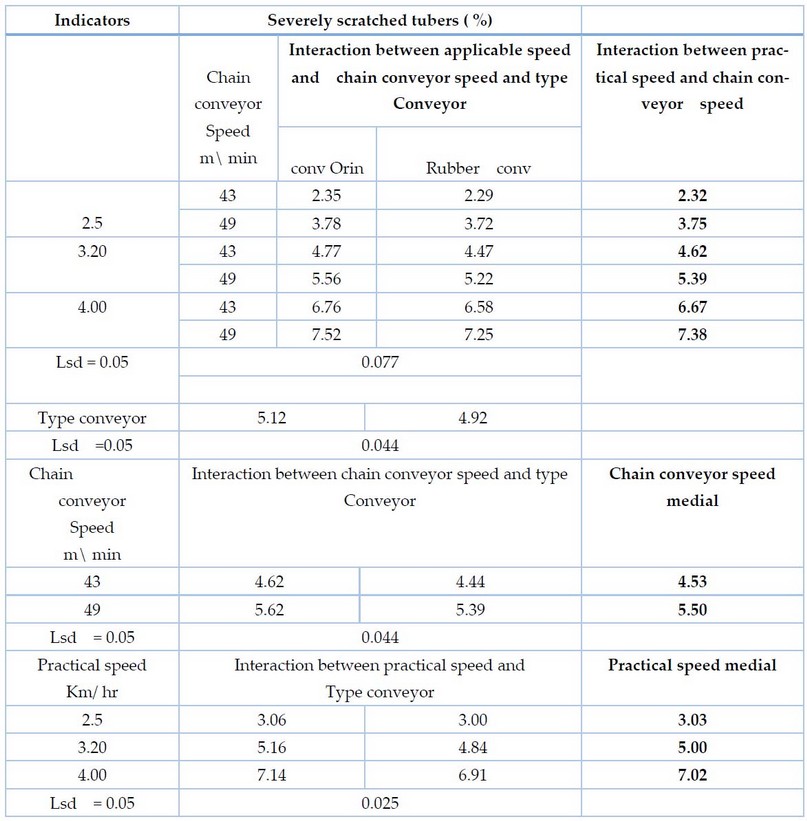
Table 1. Effect of tractor speed, chain conveyor speed, chain conveyor type and the interactions between them in severely scratched tubers
Table 2 shows the effect of the tractor's speed, the speed of the chain conveyor, the type of chain conveyor, and the interactions between them in the slightly scratched tubers, increasing the tractor speeds from 2.5 to 3.20 and then to 4.00 km .hr-1 caused a slight increase from 12.37 to 14.11 and then to 17.08 %. Table 2 shows the effect of the speed of the chain conveyor on slightly scratched tubers, as it is noted that the rate exceeded 43 m/min in achieving the lowest percentage of scratched tubers, which amounted to 14.10%, while the highest percentage of the percentage of slightly scratched tubers was in the speed of the chain conveyor 49 m/ min amounted 14.94 %. The table shows the effect of the type of chain conveyor on the percentage of slightly scratched tubers, where the rubber-coated type of rods outperformed in achieving the lowest value, amounting to 14.38 %, while the highest rate was in iron rods, amounting to 14.66%. This is consistent with the results reached 13.
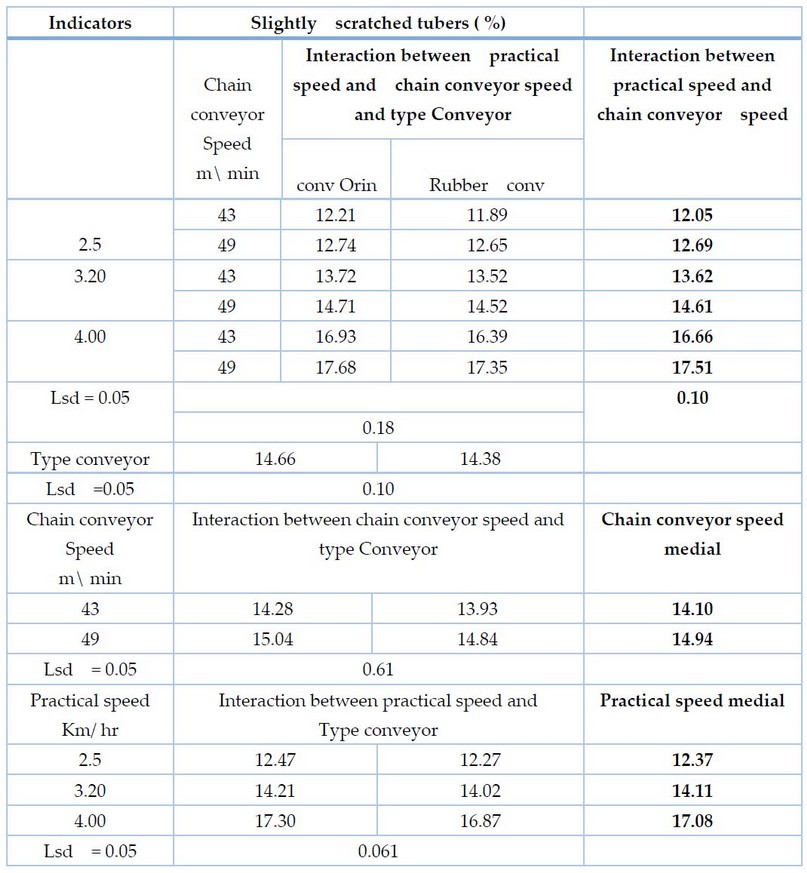
Table 2. Effect of tractor speed, chain conveyor speed, chain conveyor type and the interactions between them in slightly scratched tubers
Table 3 shows the effect of the tractor's speed, the speed of the chain conveyor, the type of chain conveyor, and the interactions between them in the quantitative loss tubers, increasing the tractor speeds from 2.5 to 3.20 and then to 4.00 km .hr-1 causing an increased quantitative loss from 1.16 to 2.17 and then to 3.57 % respectively.
Table 3 shows the effect of the speed of the chain conveyor on quantitative loss, as it is noted that the speed exceeded 43 m/min in achieving the heights percentage of quantitative loss, which amounted to 2.51 %, while the lowest rate of the percentage of quantitative loss was in the speed of the chain conveyor 49 m/ min amounted 2.09 %.
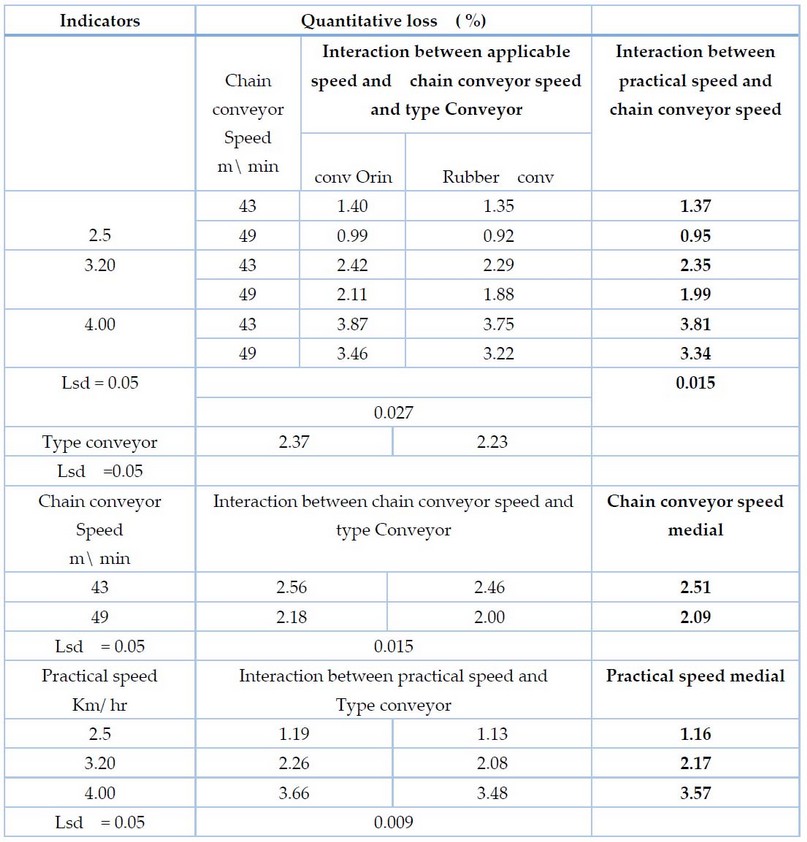
Table 3. Effect of tractor speed, chain conveyor speed, chain conveyor type and their interactions in Quantitative loss.
DISCUSSION
Increasing the tractor speeds caused an increase in severely scratched tubers; this is because when the rate is increased, it reduces the depth of the extraction digger, and the tubers are extracted at a depth less than required, and thus an increase in cutting and scratching the tubers significantly, as the relationship between the forward speed and the percentage of scratched tubers is especially and this is consistent with the results reached 11. However, increasing the tractor speeds from 2.5 to 3.20 and then to 4.00 km .hr-1 caused a slight increase from 12.37 to 14.11 and then to 17.08 %; the reason for this may be due to the rise in the speed of the system for separating or getting rid of the dirt blocks stuck to the tubers by increasing the speed, thus increasing the roughness of the effect of the machine's handling with the soil mixture and tubers and the force of the blows directed at the tubers by the vibrators of the chain conveyor, and this is consistent with the results reached 12.
Increasing the tractor speeds causes an increased quantitative loss. The reason for this may be due to an increase in the rate of the system for separating or getting rid of the dirt blocks stuck to the tubers by increasing the speed, thus increasing the roughness of the effect of the machine's handling with the soil mixture and tubers and the force of the blows directed at the tubers by the vibrators of the chain conveyor, and this is consistent with the results reached 14. The table shows the effect of the type of chain conveyor on the percentage of quantitative loss, where the rubber-coated type of rods outperformed in achieving the lowest value, amounting to 2.23 %, while the highest rate was in iron rods, amounting to 2.37%. This is consistent with the results reached 15.
CONCLUSION
From the above results, it is clear that the lowest percentage of severe scratching has been achieved at 2.5 km/h, which amounted to 3.03%, the slightly scratched amounted to 12.37%, and the lowest quantitative loss was 1.16%. At the same time, the speed of the chain conveyor 43 m/min gets the lowest percentage of severely scratched tubers, which amounted to 4.53%. The slightly scratched was 14.10%, while the speed of the chain conveyor was 49 m/min. The lowest quantitative loss was 2.09%, and the rubber rods had the lowest percentage of severely scratched tubers, slight marked and quantitative loss. Therefore, we recommend using a potato digger with a tractor speed of 2.5 km/h, a chain conveyor speed of 43 m/min and rubber-coated bars of the chain conveyor.
REFERENCES
1 Misener, G.C., L.P. McMillan, and G.C.C. Tai. Two- stag plot harvesting system for potatoes.American potato Journal, 1996; 73 (8):337-340
2 Daoud, Z.A.Al-D.;Abd Al-Wahab,H.Q. Effect of harvest dates on vegetative growth and the quantitative and qualitative characteristics of Desirio and Ajibaa potato crops, Iraq, Journal of Agricultural Sciences. 2003; 4(1) p: 28- 35
3 Bohl ,W.H. ; S.B. Johnson . Commercial Potato Production in North America. 2010; p. 75-80 .
4 Ghalib,A.K.M. Impact of speed and extraction depths on the performance of potato digger .Indian. J. of Ecology, 2019; 46 (8):246-250.
5 Baritelle , A. ; G.M. Hyde; R. Thornton and R. Bajema. Classification system for impact-related defects in potato tubers Am. J. Potato Res. 2000 , 77, 143-148 .
6 Platt, H.W., A.J. Campbell, I. Birt, and B. MacKinnon. Modification of a potato harvester for small plot field research. American Potato Journal, 1990; 67(11) : 799-803.
7 Jassem, A.R.A. L.f, Kamal, M. ; Mowaffaq, S. N. The effect of primary tillage equipment and frequency of smoothing on some technical indicators of machine and tillage quality, Iraq.Journal of Agricultural Sciences. 2006; 37 (1): 7-14
8 Peter, M.Combine Harvesters Theory , Modeling , and Design . CRC Press .Taylor &Francis Group Boca Raton London New York. 2016.
9 Aday,S.H. and S.A. Al-Maliki. Evolution of the tractor draft power losses at the different engine and forward speeds in different soil conditions.Basrah .J. Agric .Sci. 2002.15: (1).
10 Arfa , G.K. The effect of harvesting operation on potato crop handling Misr J. Ag .Eng . 2007 , 24(3) :492 -503 .
11 Al-Obaidi, O. M. M.T. The effect of the type of harvesting machine on the loss and quality of the potato crop under the influence of different harvesting dates and speeds. College of Agriculture and Forestry, University of Mosul. 2012.
12 Siddiq, A. M.A. ; Saad, A. J. Development of a mechanical separation system designed potato digger.Rafidain.Agric. Journal. 2012;40 (4).
13 Siddiq, A. M.A. S.Development of the separation device in the potato (Solanum tuberosum) digger and its performance evaluation of a Ph.D. thesis, Department of Agricultural Machinery and Machinery - College of Agriculture and Forestry - University of Mosul.2006.
14 SIddiq ,A.M.A. and Natiq ,S.H. Effect of mechanical extraction on quantitative and qualitative potato yield loss in Nnewi Governorate. M.Sc. Thesis, Department of Agriculture. 1998.
15 Da Cunha , J.P.A.R. ; D.H. Martin ; W.G Da Cunha. Operation performance of the mechanized and semi . mechanized potato harvest . Eng . Agric. , Jabot cabal , 2007; 31(4) , P. 826-834 , sul. / ago . 2011.
16 Aday, S.H. and F.M. Al-Musawi.The relationship between the specific fuel consumption and the draft energy for different engine speeds and traction wheels ballasting . Basrah. J. Agric.Sci. 2009; 22:(1).
17 Mathew, R. Impact bruise evaluation of potato tubers. M.S. thesis, Collage of Engineering and Agriculture, Washington State University, Pullman, W.A. August. 1992.
18 Naji, M. N. Effect of the operating variable of potato harvester on potato tubers damage. M. SC. thesis, Agriculture Faculty - King Saud University KSA .Mechanization, Faculty of Agriculture and Forestry, University of Mosul. 2005.
19 Sayed ,M.; A. M .Mahmooud ; M. A .Abdel-Maksoud and m.f.Fahd. An engineering study on a prototype digger for potato harvesting .Misr.G.Agric.Eng. 1996;13(1):245-261.
20 Sogut,T. F.Ozturk. Effects of harvesting time on some yield and quality traits of different maturing potato cultivars . African J. of Biotechnology. 2011;10(38):pp749-7355,25j.
Received: May 15, 2023/ Accepted: June 10, 2023 / Published: June 15, 2023
Citation: Alkaabi A, Al-Ani D F S. Effect of various tractor speeds on potato digger performance. Revis Bionatura 2023;8 (2) 77. http://dx.doi.org/10.21931/RB/2023.08.02.77